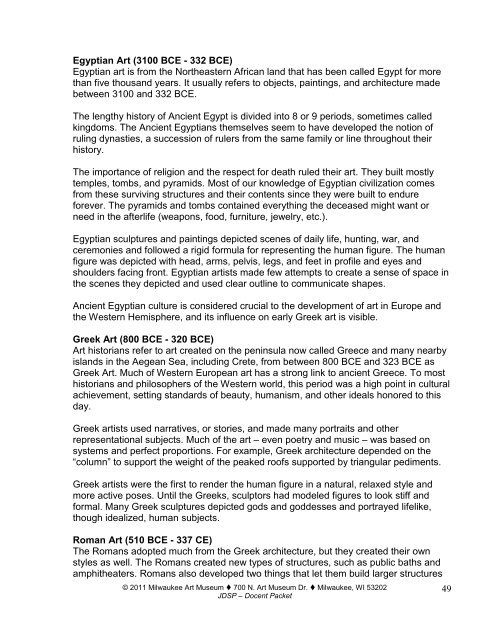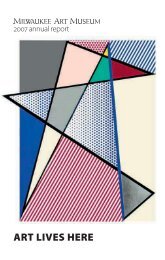Junior Docent School Program - Milwaukee Art Museum
Junior Docent School Program - Milwaukee Art Museum
Junior Docent School Program - Milwaukee Art Museum
Create successful ePaper yourself
Turn your PDF publications into a flip-book with our unique Google optimized e-Paper software.
Egyptian <strong>Art</strong> (3100 BCE - 332 BCE)<br />
Egyptian art is from the Northeastern African land that has been called Egypt for more<br />
than five thousand years. It usually refers to objects, paintings, and architecture made<br />
between 3100 and 332 BCE.<br />
The lengthy history of Ancient Egypt is divided into 8 or 9 periods, sometimes called<br />
kingdoms. The Ancient Egyptians themselves seem to have developed the notion of<br />
ruling dynasties, a succession of rulers from the same family or line throughout their<br />
history.<br />
The importance of religion and the respect for death ruled their art. They built mostly<br />
temples, tombs, and pyramids. Most of our knowledge of Egyptian civilization comes<br />
from these surviving structures and their contents since they were built to endure<br />
forever. The pyramids and tombs contained everything the deceased might want or<br />
need in the afterlife (weapons, food, furniture, jewelry, etc.).<br />
Egyptian sculptures and paintings depicted scenes of daily life, hunting, war, and<br />
ceremonies and followed a rigid formula for representing the human figure. The human<br />
figure was depicted with head, arms, pelvis, legs, and feet in profile and eyes and<br />
shoulders facing front. Egyptian artists made few attempts to create a sense of space in<br />
the scenes they depicted and used clear outline to communicate shapes.<br />
Ancient Egyptian culture is considered crucial to the development of art in Europe and<br />
the Western Hemisphere, and its influence on early Greek art is visible.<br />
Greek <strong>Art</strong> (800 BCE - 320 BCE)<br />
<strong>Art</strong> historians refer to art created on the peninsula now called Greece and many nearby<br />
islands in the Aegean Sea, including Crete, from between 800 BCE and 323 BCE as<br />
Greek <strong>Art</strong>. Much of Western European art has a strong link to ancient Greece. To most<br />
historians and philosophers of the Western world, this period was a high point in cultural<br />
achievement, setting standards of beauty, humanism, and other ideals honored to this<br />
day.<br />
Greek artists used narratives, or stories, and made many portraits and other<br />
representational subjects. Much of the art – even poetry and music – was based on<br />
systems and perfect proportions. For example, Greek architecture depended on the<br />
“column” to support the weight of the peaked roofs supported by triangular pediments.<br />
Greek artists were the first to render the human figure in a natural, relaxed style and<br />
more active poses. Until the Greeks, sculptors had modeled figures to look stiff and<br />
formal. Many Greek sculptures depicted gods and goddesses and portrayed lifelike,<br />
though idealized, human subjects.<br />
Roman <strong>Art</strong> (510 BCE - 337 CE)<br />
The Romans adopted much from the Greek architecture, but they created their own<br />
styles as well. The Romans created new types of structures, such as public baths and<br />
amphitheaters. Romans also developed two things that let them build larger structures<br />
© 2011 <strong>Milwaukee</strong> <strong>Art</strong> <strong>Museum</strong> 700 N. <strong>Art</strong> <strong>Museum</strong> Dr. <strong>Milwaukee</strong>, WI 53202<br />
JDSP – <strong>Docent</strong> Packet<br />
49
















